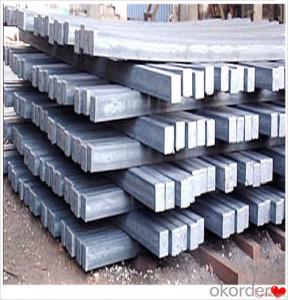Square Steel Billets Q235,Q255,Q275,Q345,3SP,5SP,20MnSi
- Loading Port:
- China main port
- Payment Terms:
- TT OR LC
- Min Order Qty:
- 20 m.t.
- Supply Capability:
- 200000 m.t./month
OKorder Service Pledge
OKorder Financial Service
You Might Also Like
Square Steel Billets Q235,Q255,Q275,Q345,3SP,5SP,20MnSi
Specification
Steel billet(ingot) by cogging or breakdown of semi-finished products, is the raw material of all kinds of steel mill. Billet section of square, round, flat, rectangular and abnormity of several kinds of, mainly related to the shape of rolled products.
CNBM Q235,Q275,Q345,3SP,5SP,20MnSi Billets Steel
Hot Rolled Steel Billets/ Mild Steel Bar/ Billet Steel
Specification (see below)
Standard: GB/JIS/ASTM
Size: 50*50mm-180*180mm
Length: 3-12mtrs or Customised
Steel material: Q235,Q255,Q275,Q345,3SP,5SP,20MnSi
Technique: Hot rolled
FOB Unit Ton Price $250-350 and Usually I will quote you CFR price.
MOQ: Usually 1000-10000MT/size
Shipment:By Container,Bulk Vessel
Packaging Details: bundles with steel strips or as customers's requirements
Delivery time: Usually within 30 days after the deposit/LC
Inspection:Third party inspection before loading.
Technical data
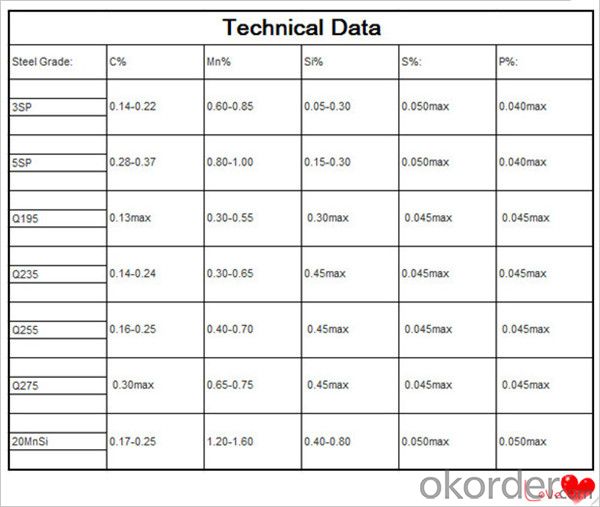
Feature Steel Billet
Rectangular billet continuous casting billet and mainly general carbon steel, low carbon low silicon cold-rolled material, high quality carbon structural steel, high strength low alloy steel, special steel, etc.
The billet is mainly divided into two kinds from the shape:
Slab: cross section width and height of the ratio of the larger, mainly used for rolling plate.
Billet: equal cross section width and height, or a huge difference, mainly used for rolling steel, wire rod. ,
Steel billets have distinct characteristics as compared with already furnished steel bars and products. Billets have a specific grain structure, which enables the metal to be processed more intricately. Steel billets are also known for their malleability and ductility, especially when exposed to varying temperatures during shaping and molding.
Packaging & Shipping
1. Packaging:
1) Small size: in bundles
2)Big size: in bulk
3)in plastic packing or as per customer requirement
2. Delivery time:
1) Normal size: within 7days send from warehouse directly
2) Special size: with 25-30days customer made for you
3. Trade terms:FOB/CFR/CIF
4. Shippment:
1) length:≤5.8m loaded in 20FT Container with 25-27tons
2) length:≤11.8m loaded in 40FT Container with 25-27tons
3) lengnth:≥12m shipped by bulk vessel, FILO terms
Steel Billet Images
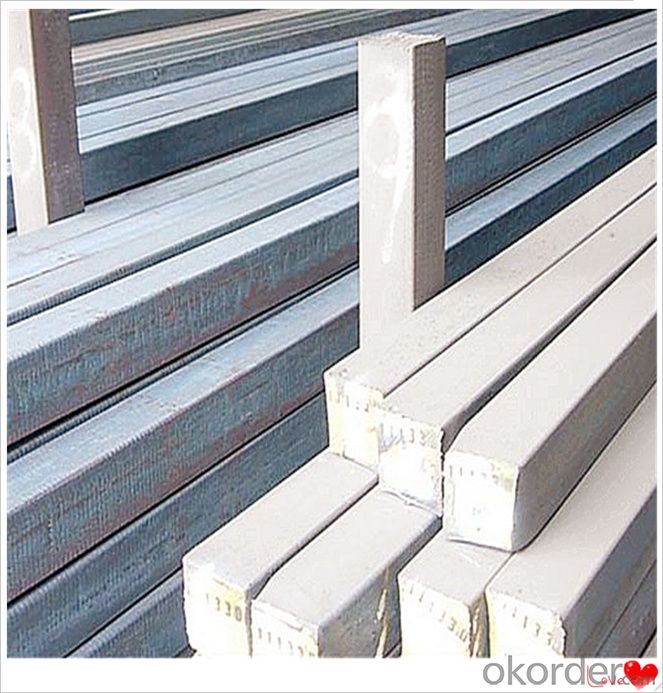
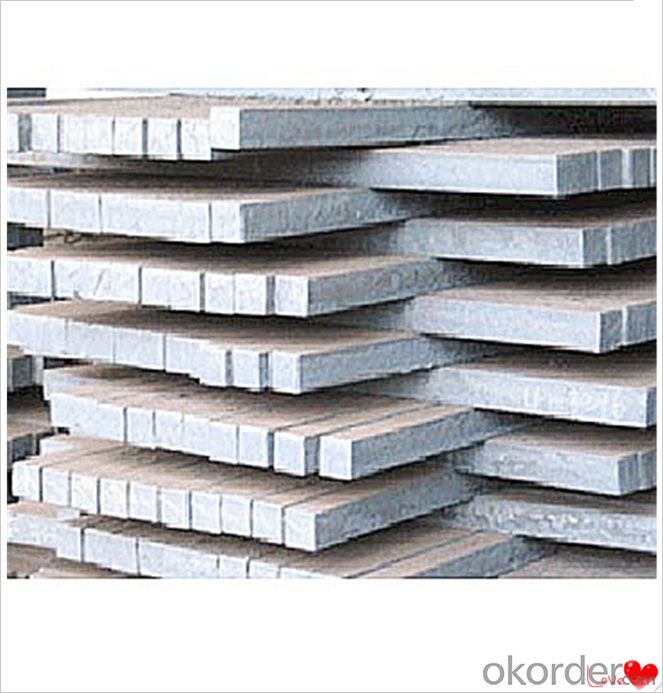
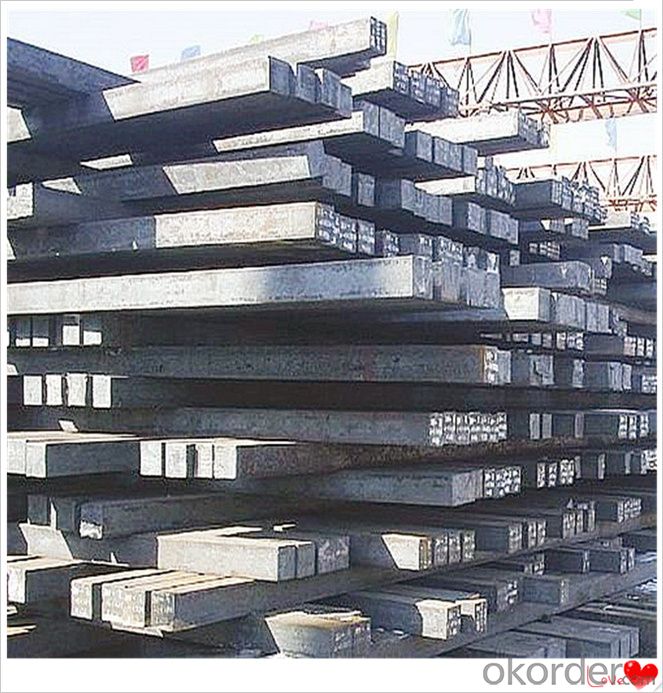

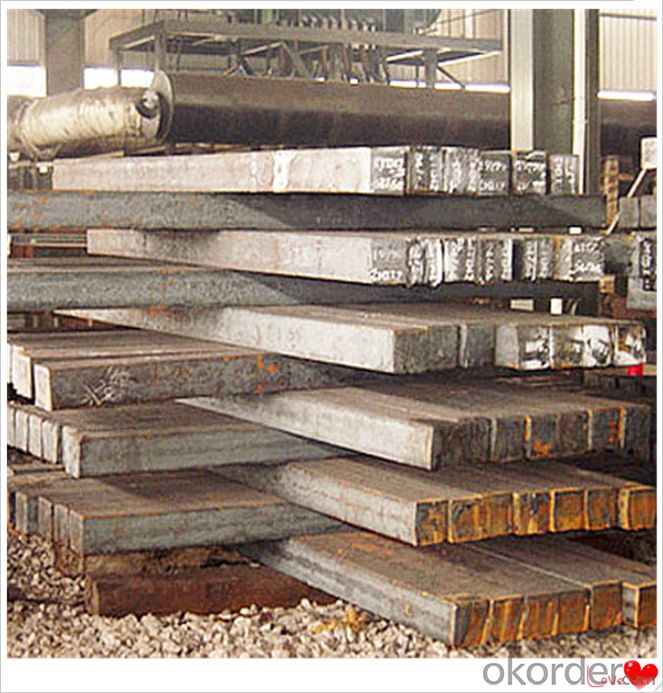
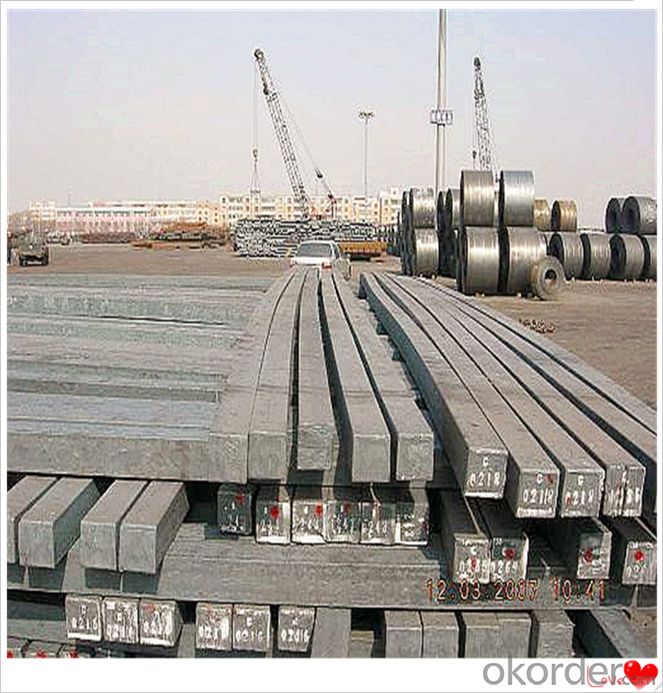
Processing
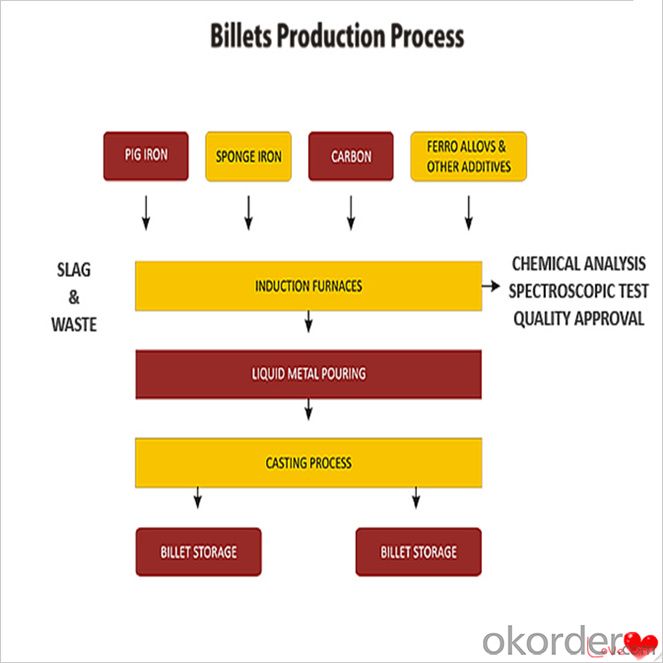
Usage-Billet Steel
Used for the plant, the bridge,shipment building high-rise building construction,lifting and transportation machinery, equipment manufracturing base building the support foundation pile manufacturing.
Billets, or ingots (as they sometimes referred to), are not of practical use until they have been formed into more functional shapes and sizes. While they have already been put in the furnace, they still require a series of shaping and molding procedures such as hot and cold working, milling and cutting before they are sold in hardware stores, or used for different applications. The unformed billets, however, can be used in striking currency such as coins and as reserves, similar to gold bars.
FAQ-Billet Steel
We have organized several common questions for our clients,may help you sincerely:
1) How about your company?
A world class manufacturer & supplier of castings forging in carbon steel and alloy steel,is one of the large-scale professional investment casting production bases in China,consisting of both casting foundry forging and machining factory. Annually more than 8000 tons Precision casting and forging parts are exported to markets in Europe,America and Japan. OEM casting and forging service available according to customer’s requirements.
2) How to guarantee the quality of the products?
We have established the international advanced quality management system,every link from raw material to final product we have strict quality test;We resolutely put an end to unqualified products flowing into the market. At the same time, we will provide necessary follow-up service assurance.
3) How long can we receive the product after purchase?
In the purchase of product within three working days, We will arrange the factory delivery as soon as possible. The pecific time of receiving is related to the state and position of customers.Commonly 7 to 10 working days can be served.
4)Do you have your own QC department?
Yes, we have, our QC department will inspect the goods during the process of mass production and after completion of production.
hot sale!!! Cast Steel Grades/ mild steel bar/ billet steel
(1): High quality steel with reasonable price.
(2): Wide excellent experiences with after-sale service.
(3): Every process will be checked by responsible QC which insures every product's quality.
(4): Professional packing teams which keep every packing safely.
(5): Trial order can be done in one week.
(6): Samples can be provided as your requirements.
- Q:Are billet metals within the metal range?
- Ah, metal materials, ferrous metals, color metals, two kinds of billets belong to ferrous metals, copper and copper alloys, aluminum and aluminum alloys, belonging to color metal
- Q:What are the different types of tests conducted on steel billets?
- Steel billets undergo various tests to assess their quality and suitability for different applications. These tests play a crucial role in determining the mechanical properties, chemical composition, and overall integrity of the billets. 1. Analyzing Chemical Composition: The chemical composition of the steel billets is examined to ensure compliance with specified standards and requirements. This analysis measures the levels of carbon, manganese, silicon, sulfur, and phosphorus, among other elements. 2. Tensile Strength Evaluation: The tensile test assesses the ability of the steel billets to withstand pulling forces without breaking. It measures parameters such as tensile strength, yield strength, and elongation. 3. Determining Hardness: The hardness test evaluates the steel billets' resistance to wear, deformation, and penetration. It involves different hardness tests such as Brinell, Rockwell, and Vickers. 4. Assessing Impact Resistance: The impact test measures the toughness and capacity of the steel billets to absorb energy under sudden loading or impact conditions. It helps determine their resistance to fracture and cracking. 5. Ultrasonic Inspection: This non-destructive test employs high-frequency sound waves to detect internal flaws or defects in the steel billets. It is a valuable method for identifying cracks, voids, and inclusions that may compromise the billets' structural integrity. 6. Verifying Dimensions: The dimensional inspection ensures that the steel billets meet the specified dimensional requirements, including length, width, and thickness. This verification confirms their suitability for intended applications and subsequent manufacturing processes. 7. Macroscopic Examination: This visual inspection involves magnified examination of the steel billets' surface and internal structure. It helps identify visible defects like cracks, porosity, segregation, or irregularities. 8. Microscopic Examination: By using a microscope, the microscopic examination analyzes the microstructure of the steel billets. It provides insights into grain size, presence of phases, and any abnormalities that may affect the steel's properties. Collectively, these tests guarantee that the steel billets meet the required quality standards and possess the necessary mechanical properties for their intended applications. They ensure the safety, reliability, and performance of steel billets in industries like construction, automotive, aerospace, and manufacturing.
- Q:How do steel billets contribute to the manufacturing of tools and equipment?
- Steel billets are an integral component in the manufacturing of tools and equipment. These billets, which are essentially semi-finished steel products, play a crucial role in shaping and forming the final products used in various industries. Firstly, steel billets are used as raw material in the production of various types of tools and equipment. They serve as the starting point for manufacturing processes such as forging, rolling, and extrusion. These processes involve heating and shaping the steel billets to create the desired form and dimensions of the tools and equipment. Moreover, steel billets offer several advantages that make them suitable for tool and equipment manufacturing. The high strength and durability of steel make it an ideal material for tools that need to withstand heavy loads and harsh conditions. The versatility of steel allows for the production of a wide range of tools and equipment, including cutting tools, machine parts, construction equipment, and automotive components. Additionally, steel billets can be easily machined and formed into complex shapes, enabling the production of intricate tools and equipment that meet specific requirements. The excellent machinability of steel allows for precise cutting, drilling, and milling processes, resulting in accurate dimensions and smooth surfaces. Furthermore, steel billets can be heat-treated to enhance their mechanical properties, such as hardness and toughness. Heat treatment processes like quenching and tempering can significantly improve the performance and longevity of tools and equipment. These processes, combined with the inherent strength of steel, ensure that the final products have the necessary strength, hardness, and wear resistance to perform their intended functions effectively. In summary, steel billets are essential in the manufacturing of tools and equipment due to their raw material capabilities and advantageous properties. They provide a reliable and versatile starting point for the production of various tools and equipment, enabling the creation of durable, precise, and high-performance products that are vital to numerous industries.
- Q:What are the different surface treatments for rust prevention in steel billets?
- There are several surface treatments available for rust prevention in steel billets. These treatments aim to protect the steel surface from corrosion caused by exposure to moisture or other corrosive elements. Some of the commonly used surface treatments include: 1. Hot-dip galvanizing: This process involves immersing the steel billets in a bath of molten zinc, which creates a protective layer on the surface. The zinc coating acts as a barrier against corrosion, preventing the steel from coming into contact with corrosive elements. 2. Electroplating: In this method, a thin layer of a corrosion-resistant metal, such as zinc, nickel, or chromium, is deposited onto the steel billet surface using an electric current. The electroplated layer provides a protective barrier against rust formation. 3. Paint coatings: Applying a layer of paint on the steel billet surface can effectively prevent rust. The paint forms a protective barrier, preventing moisture or corrosive substances from reaching the steel surface. Multiple layers of paint, including primer and topcoat, are typically applied to enhance durability. 4. Powder coating: This process involves applying a dry powder, usually made of epoxy, polyester, or acrylic, to the steel billet surface. The powder is electrostatically charged and adheres to the metal, forming a protective coating when heated. Powder coating provides excellent corrosion resistance and durability. 5. Phosphating: Phosphating is a chemical treatment method that involves applying a phosphate coating to the steel surface. The phosphate layer enhances the steel's resistance to corrosion and provides a good base for subsequent paint or powder coating. 6. VCI (Vapor Corrosion Inhibitor) packaging: This method utilizes special packaging materials that release volatile corrosion inhibitors. These inhibitors create a protective atmosphere around the steel billets, preventing rust formation during storage or transportation. It is important to note that the choice of surface treatment depends on factors such as the steel's intended application, environment, and cost considerations. Each treatment method has its advantages and limitations, and it is essential to select the most appropriate treatment for effective rust prevention in steel billets.
- Q:Can steel billets be painted or coated for decorative purposes?
- Yes, steel billets can be painted or coated for decorative purposes. The surface of steel billets can be prepared and treated to ensure proper adhesion of paint or coating, allowing for customization and enhancing their appearance for decorative applications.
- Q:How do steel billets contribute to the overall sustainability of a product?
- The overall sustainability of a product is greatly enhanced by the use of steel billets. Firstly, steel is a widely recycled material, and the incorporation of steel billets into the manufacturing process enables a closed-loop recycling system. This system allows for continuous recycling and reusing of the steel billets without any loss in quality or performance. By recycling steel, the extraction of raw materials is reduced, conserving natural resources and decreasing energy consumption. Ultimately, this reduces the carbon footprint of the product. In addition, the use of steel billets contributes to the durability and longevity of a product. Steel is a highly durable material that can withstand harsh environmental conditions and heavy usage. By incorporating steel billets in the production process, products are made to last longer, reducing the need for frequent replacement and minimizing waste generation. Furthermore, steel billets find applications in various industries such as construction, automotive, and manufacturing, where sustainability is of utmost importance. Steel structures and components made from steel billets are renowned for their high strength-to-weight ratio, allowing for lighter structures and vehicles. This results in reduced energy consumption during transportation and improved fuel efficiency, particularly in the case of automobiles. Consequently, greenhouse gas emissions are reduced. Moreover, steel is a non-toxic material that does not release harmful substances into the environment. This ensures that products made from steel billets are safe for both consumers and the environment throughout their lifecycle. In conclusion, steel billets make a significant contribution to the overall sustainability of a product. They enable closed-loop recycling, reduce the need for raw materials extraction, increase product durability, promote energy efficiency, and are non-toxic. By incorporating steel billets into the production process, manufacturers can enhance the environmental performance of their products and contribute to a more sustainable future.
- Q:What are the common uses of steel billets?
- Steel billets are semi-finished metal products that serve as a precursor to various steel products. They are typically produced through the process of continuous casting or hot rolling, resulting in a solid, rectangular shape. Due to their versatility and strength, steel billets have numerous common uses across various industries. One of the primary applications of steel billets is in the production of long steel products such as bars, rods, and wires. These billets serve as the starting material for further processing, where they are reheated and shaped into the desired form. Long steel products find extensive use in construction, infrastructure development, manufacturing, and transportation industries. Steel billets are also utilized in the production of seamless pipes and tubes. By subjecting the billets to the process of piercing and elongation, they can be transformed into seamless tubes that are widely used in oil and gas exploration, automotive manufacturing, and structural engineering. Furthermore, steel billets play a crucial role in the production of forged steel components. Forging involves shaping the heated billet through the application of pressure, resulting in high-strength and durable products. These forged components are widely used in industries such as aerospace, automotive, and power generation. In addition to these applications, steel billets are also used in the production of various other steel products like beams, channels, and profiles for construction purposes, as well as in the manufacturing of machine parts and tools. Overall, the common uses of steel billets can be summarized as the starting material for the production of long steel products, seamless pipes, forged components, and other steel products. Their versatility, strength, and malleability make steel billets an essential raw material in numerous industries.
- Q:What are the main factors affecting the formability of alloy steel billets?
- The formability of alloy steel billets, which refers to the ability of the material to be shaped or formed without cracking or fracturing, is influenced by several key factors. 1. Alloy composition: The alloy composition of steel billets plays a significant role in determining their formability. Different alloying elements such as carbon, manganese, chromium, and nickel can alter the mechanical properties of the steel, including its ductility and toughness. Higher levels of certain elements can improve formability, while excessive amounts can lead to brittleness and reduced formability. 2. Grain size and structure: The grain size and structure of the steel billets also affect formability. Fine-grained structures have better formability compared to coarser grain sizes. This is because fine grains allow for more uniform deformation and reduce the likelihood of localized strain concentration, which can lead to cracking. 3. Temperature: The temperature at which the steel billets are processed greatly influences their formability. The material's ductility and ability to deform without cracking are generally enhanced at higher temperatures. This is due to the reduction in the material's yield strength and increased plasticity. However, excessively high temperatures can also lead to excessive grain growth and decreased formability. 4. Strain rate: The rate at which the steel billets are deformed is another important factor. Higher strain rates can result in reduced formability, as the material may not have sufficient time to accommodate the deformation before fracture occurs. Controlling the strain rate during forming processes is crucial to ensure optimal formability. 5. Lubrication: The use of lubricants during the forming process can significantly improve the formability of steel billets. Lubricants reduce friction between the material and the forming tools, minimizing the risk of sticking or tearing. They also help dissipate heat generated during deformation, preventing excessive temperature rise that can negatively impact formability. 6. Forming process: The specific method used to shape the steel billets can also affect formability. Different processes, such as forging, rolling, or extrusion, impose varying levels of strain and stress on the material. Each process has its own limitations and requirements for optimal formability, and selecting the appropriate forming method is crucial to achieve the desired shape without compromising the material's integrity. In summary, the formability of alloy steel billets is influenced by their alloy composition, grain size and structure, temperature, strain rate, lubrication, and the chosen forming process. Understanding and controlling these factors are essential for achieving the desired shape and avoiding defects or failures during the forming of alloy steel billets.
- Q:How is the quality of steel billets determined?
- The determination of steel billet quality involves a combination of physical and chemical tests, which are conducted to ensure that the steel meets the necessary standards and specifications for its intended use. Chemical analysis is a primary method employed to assess the quality of steel billets. This procedure involves testing the steel's composition to verify that it contains the appropriate levels of various elements, such as carbon, manganese, silicon, and others. The steel's chemical composition plays a critical role in determining its mechanical properties, such as strength, hardness, and more. In addition to chemical analysis, several physical tests are conducted to evaluate the quality of steel billets. These tests include measuring the dimensions, weight, and straightness of the billets to ensure they adhere to the specified tolerances. Surface inspections are also performed to detect any defects, like cracks, seams, or irregularities, that may impact the steel's performance. Mechanical tests are another vital aspect of determining steel billet quality. These tests assess the steel's mechanical properties, including strength, ductility, toughness, and hardness. Tensile tests are frequently conducted to determine the maximum load the steel billet can bear before breaking or deforming. Impact tests are also performed to evaluate the steel's ability to withstand sudden shocks or impacts. Additionally, non-destructive testing techniques are utilized to identify any internal defects or inconsistencies within the steel billets. These methods, such as ultrasonic testing, magnetic particle inspection, and radiographic testing, aid in ensuring that the steel is devoid of any hidden defects that could compromise its quality or structural integrity. Overall, the quality of steel billets is determined through a comprehensive evaluation involving chemical analysis, physical tests, mechanical tests, and non-destructive testing. These methods guarantee that the steel meets the necessary standards and specifications, providing assurance of its reliability and suitability for various applications.
- Q:Are steel billets used in the production of electrical transmission towers?
- The utilization of steel billets is widespread in the manufacturing of electrical transmission towers. At the onset of the production process, steel billets serve as the primary form of steel. They are typically shaped and sized through hot rolling, resulting in various sections and components required for constructing transmission towers. Due to its remarkable strength and durability, steel emerges as the perfect material for such structures, which must endure harsh environmental conditions and uphold heavy electrical conductors. Additionally, steel possesses exceptional electrical conductivity properties, a vital characteristic for ensuring the efficient transmission of electricity through the towers. In summary, steel billets assume a pivotal role in the creation of electrical transmission towers, guaranteeing their strength, durability, and efficiency.
1. Manufacturer Overview |
|
|---|---|
| Location | |
| Year Established | |
| Annual Output Value | |
| Main Markets | |
| Company Certifications | |
2. Manufacturer Certificates |
|
|---|---|
| a) Certification Name | |
| Range | |
| Reference | |
| Validity Period | |
3. Manufacturer Capability |
|
|---|---|
| a)Trade Capacity | |
| Nearest Port | |
| Export Percentage | |
| No.of Employees in Trade Department | |
| Language Spoken: | |
| b)Factory Information | |
| Factory Size: | |
| No. of Production Lines | |
| Contract Manufacturing | |
| Product Price Range | |
Send your message to us
Square Steel Billets Q235,Q255,Q275,Q345,3SP,5SP,20MnSi
- Loading Port:
- China main port
- Payment Terms:
- TT OR LC
- Min Order Qty:
- 20 m.t.
- Supply Capability:
- 200000 m.t./month
OKorder Service Pledge
OKorder Financial Service
Similar products
New products
Hot products
Related keywords
